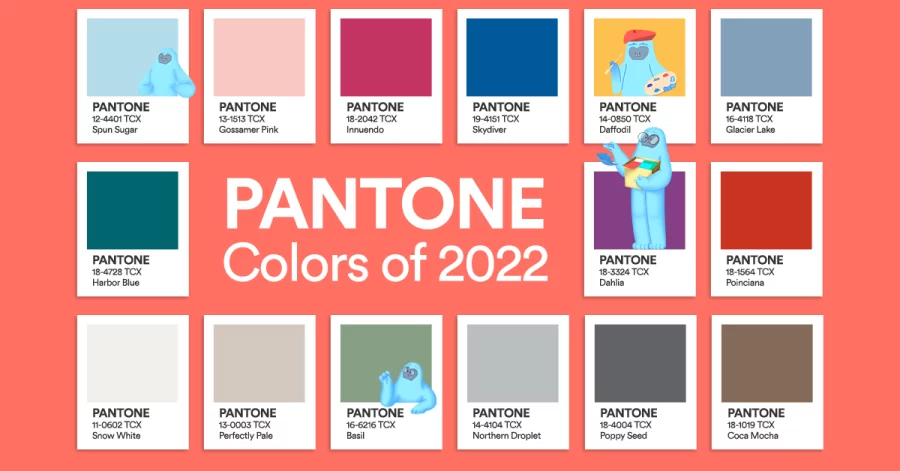
In late October, Adobe removed support for free Pantone colors across its Creative Cloud applications. Any PSD files a user had that contained Pantone colors were switched to black, forcing users to switch colors or pay a $15/month subscription. This move caused outrage among long-time Adobe users who felt it was ridiculous to be charged for what was essentially a list of numbers.
For the uninformed, the Pantone Color Matching System is a universal color guide owned by Pantone LLC. Before Pantone, every printing company had its own color guide meaning “Red” was printed differently depending on who was printing it. With the Pantone system, different manufacturers in different areas all over the world can ensure they have consistent colors. Previously, Adobe users could access the Pantone library and use it freely in their work freely. That is until this year.
What’s the big deal with the colors? And why is Pantone charging for access to a color? To answer this, let’s dive into the world of Big Color.
The Importance of Color in Industries

Colors play a significant role in various industries, such as fashion, design, and marketing. In the fashion industry, colors are used to create visually appealing and eye-catching clothing, accessories, and other fashion items. Different colors can convey different moods and styles, and they can also be used to make a fashion statement or express a particular brand identity.
In the design industry, colors are an essential element of visual communication and aesthetics. Designers use colors to create a desired look and feel for a product, service, or environment. Colors can be used to convey a specific message or emotion, and they can also be used to create visual harmony and balance.
In the marketing industry, colors are a powerful tool for influencing consumer behavior and decision-making. Marketers use colors to attract attention, differentiate their products, and create a strong brand identity. Different colors can evoke different emotions and associations, and they can also be used to target specific audiences and demographics.
Overall, the importance of colors in these industries lies in their ability to communicate, differentiate, and influence. Colors are an essential part of the visual language that we use to convey ideas, express ourselves, and connect with others.
The Color Creation Process

The process of inventing a new color typically involves several steps and tools. Here is an overview of the general process of inventing a new color:
- Research and identify a need for a new color: The first step in inventing a new color is to conduct research and identify a need for a new color. This can involve market research, consumer surveys, and industry analysis to determine what colors are currently available and what colors are in demand. This step can also involve brainstorming and concept development to come up with new color ideas.
- Create a color sample: Once a need for a new color has been identified, the next step is to create a color sample. This typically involves using color-matching software or a color-mixing system to create a physical or digital sample of the new color. The color sample can be tested and adjusted to ensure that it is unique and appealing.
- Test and validate the new color: The next step is to test and validate the new color to ensure that it meets the desired specifications and standards. This can involve conducting lab tests and experiments to measure the color’s accuracy, durability, and compatibility with other materials. It can also involve conducting market research and consumer surveys to gather feedback and validate the color’s appeal and potential market value.
- Obtain intellectual property protection: If the new color is unique and valuable, the next step is to obtain intellectual property protection for the color. This can involve applying for a patent or a trademark for the new color. Additionally, the company may have legal protection and exclusivity for the color, allowing the company to license the color to other companies and generate revenue from its invention.
Inventing a new color involves a combination of research, creativity, and technical expertise. With a deep understanding of color science, market trends, and consumer preferences, and with the ability to create and test new color samples, color-invention requires a solid understanding of intellectual property law and the ability to protect the company’s intellectual property rights.
What Methods Are Used for Creating a Color?

Companies use various methods to create new colors, depending on the specific requirements and goals of the color. Here are some common methods that companies use to create new colors:
- Color-mixing systems: Companies often use color-mixing systems to create new colors. These systems typically consist of a set of primary colors (e.g., red, yellow, blue) that can be mixed in different proportions to create a wide range of colors. Color-mixing systems can be used to create new colors manually or using color-matching software.
- Pigment-based colors: Companies can also create new colors using pigments. Pigments are substances that absorb certain wavelengths of light and reflect others, resulting in a specific color. Different pigments can be combined in different proportions to create new colors. Pigment-based colors are often used in industries such as printing, painting, and cosmetics.
- Dye-based colors: Companies can also create new colors using dyes. Dyes are soluble substances that can be dissolved in a solvent, such as water or oil, to create a colored solution. Different dyes can be mixed to create new colors, and the resulting solutions can be applied to various materials, such as fabrics, paper, or wood. Dye-based colors are often used in industries such as textiles, printing, and food.
- Fluorescent colors: Companies can also create new colors using fluorescent pigments or dyes. Fluorescent colors are colors that absorb light in the ultraviolet or violet range and emit light in the visible range, resulting in a bright and vivid color. Fluorescent colors are often used in products that need to be highly visible, such as safety gear and emergency equipment.
Challenges in Color Creation
Creating a new color isn’t as simple as picking a random spot on a color wheel. Here are some common challenges and considerations involved in creating a new color:
- Technical challenges: One of the main challenges in creating a new color is the technical complexity of color science. Creating a new color involves understanding the properties of light, color perception, and color-mixing systems, as well as the technical requirements and standards of different industries. This requires a deep understanding of color science and the ability to create and test new color samples.
- Intellectual property challenges: Another challenge in creating a new color is the need to protect the company’s intellectual property rights. Inventing a new color can be valuable intellectual property for a company, but it requires a solid understanding of intellectual property law and the ability to apply for patents and trademarks. This can be a complex and time-consuming process, and it requires the help of legal experts and consultants.
- Market challenges: Another challenge in creating a new color is the need to validate the color’s appeal and potential market value. Creating a new color is not just a technical exercise; it also requires a deep understanding of consumer preferences, market trends, and industry standards. This requires conducting market research, consumer surveys, and other forms of feedback to ensure that the new color is unique and appealing.
- Financial challenges: Creating a new color can also be a financial challenge for a company. The process of inventing a new color can be time-consuming and costly, and it requires significant resources and investment. This can be a risk for companies, as there is no guarantee that the new color will be successful or profitable. Companies need to carefully assess the potential financial benefits and risks of inventing a new color.
The Value of a New Color

A new color can have significant value to a company and its customers. For instance, a new color can give you:
- Differentiation: A new color can provide a company with a unique and distinctive selling point for its products. With a differentiating shade, a product could stand out from its competitors, giving it a competitive advantage. Also, it can also help a company to create a strong and memorable brand identity, which can drive sales and increase customer loyalty.
- Innovation: A new color can also be a valuable source of innovation for a company. Inventing a new color requires creativity, technical expertise, and market knowledge, and it can be a valuable part of a company’s research and development efforts. As a valuable asset for a company, new colors can be used to create new products, services, or experiences.
- Revenue: A company can patent a new color and license it to other companies, generating revenue from its invention. A new color can also be a valuable asset for a company, as it can be sold or used as collateral for loans.
- Customer value: A new color can also provide value to customers. A new color can enhance the aesthetic appeal and functionality of a product, making it more attractive and appealing to customers. A new color can also provide customers with new options and choices, allowing them to express themselves and personalize their products.
Companies That Have Successfully Marketed New Colors
Pantone

As mentioned above, Pantone has invented many new colors, including its famous “Pantone Color of the Year,” which is a new color that Pantone selects each year. Pantone licenses its colors to other companies and sells color-matching products and services. They currently have over 2000 colors patented along with some special colors they have created for celebrities like Jay-Z, who owns a shade of blue with a secret name.
Crayola

Crayola is a company that manufactures and markets art supplies, including crayons, markers, and colored pencils. Crayola has invented many new colors for its products, including its famous “Crayola Color of the Year.” Crayola’s new colors have helped the company to differentiate its products and drive sales.
Sherwin Williams

Sherwin-Williams is a company that manufactures and sells paint, coatings, and other products for the construction and design industries. With over 400 patents, Sherwin-Williams paint color coding system starts with “SW” for Sherman Williams and a four digit code for each patented color.
LEGO

LEGO is one of the oldest toy companys that manufactures colored toy blocks. Each toy block can be joined together to form structures and objects. The LEGO Group’s color history is wide and varied without a finite, coherent color coding system. Nonetheless, the current color pallete of 39 colors is part of LEGO’s 1,655 active patents in design and color.
DISNEY

Disney secretly invented two colors! They are used to be ignored. Go Away Green and Blending Blue are two of the most used paint colors at Walt Disney World Resort, but each particular shade was specifically engineered by Disney “Imagineers” to make your eyes ignore them.
